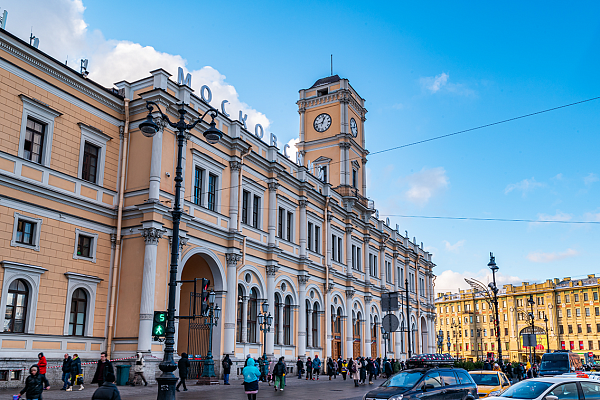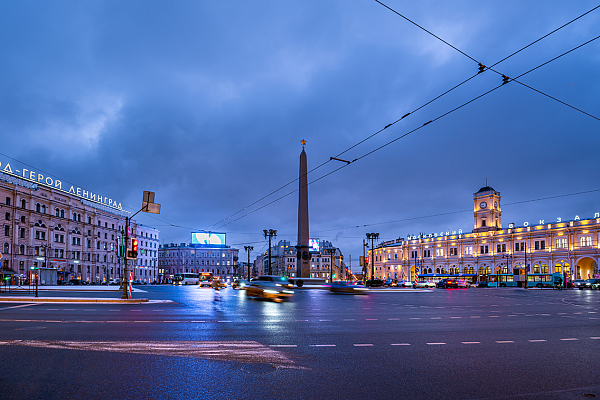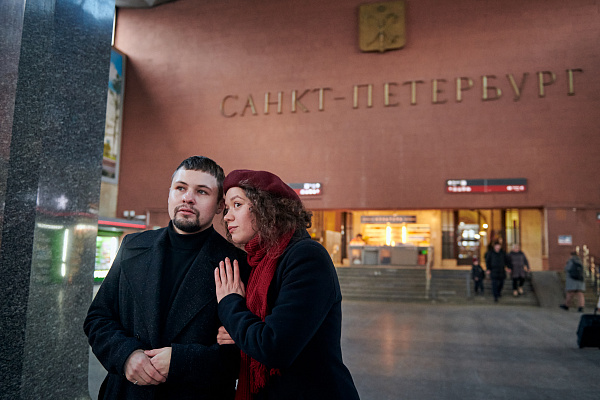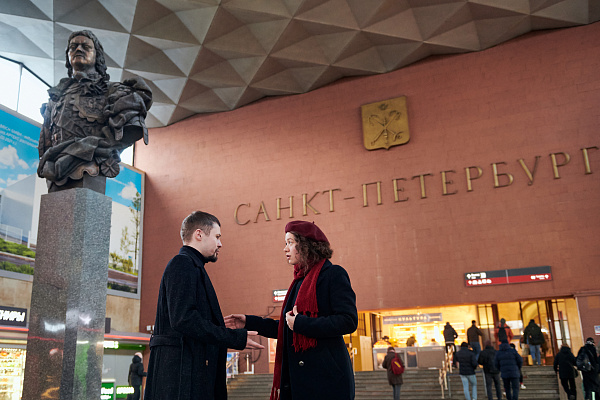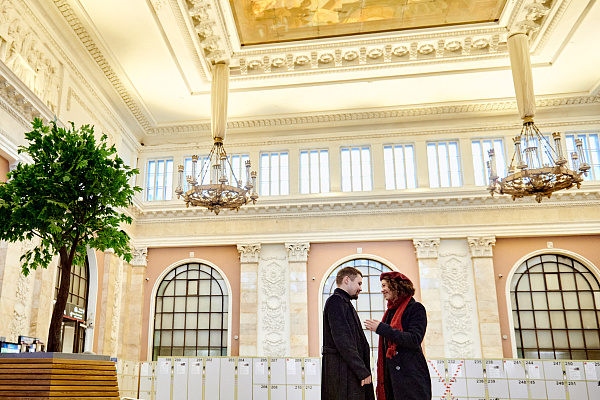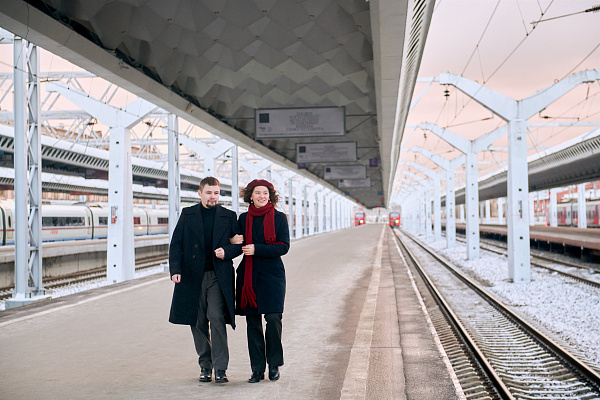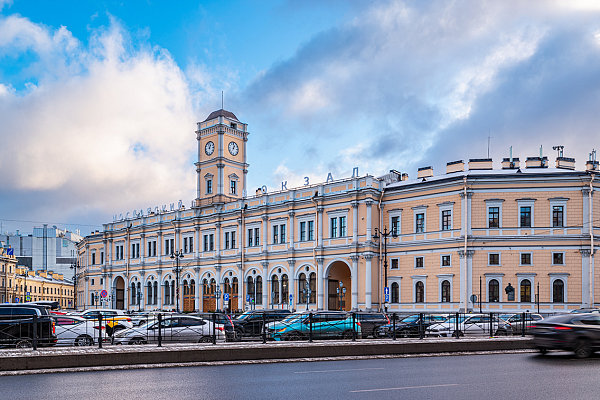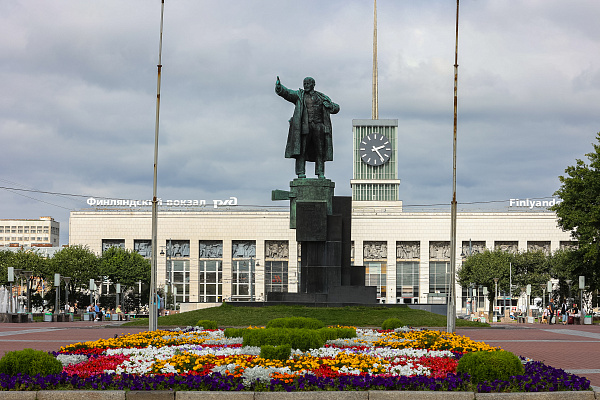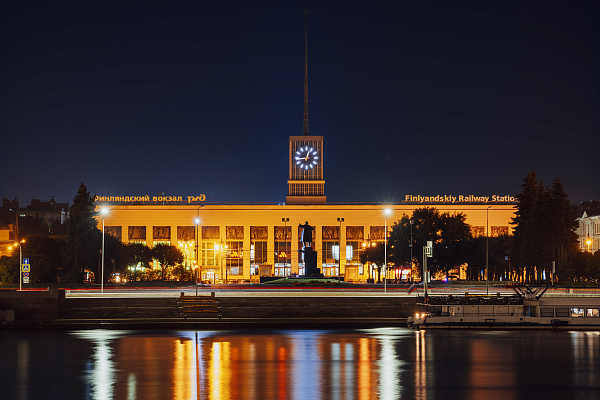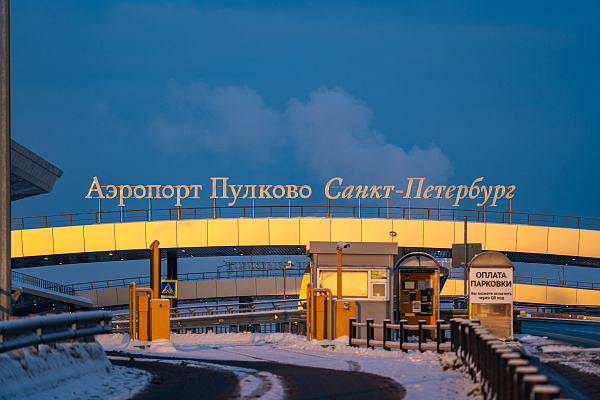How to get to St. Petersburg
-
Railway stations
-
Sea and river ports
-
Bus stations
-
Airports
Moskovsky railway station
One of the five largest railway stations in Russia
The design of the passenger station in St. Petersburg began in 1843.
From here, in the middle of the 19th century, the first in Russia, the largest at that time in Europe, double-track mainline St. Petersburg-Moscow railway extended to Moscow.
In 1844, the projects of the stations by the architect K.A. Ton were approved for both St. Petersburg and Moscow.
On November 1, 1851, the official opening of the St. Petersburg-Moscow railway and the beginning of regular passenger service took place.
On the day of the departure of the first train, November 1 (13), 1851, the Nikolaevsky station also opened its doors. The building consisted of a main building with a facade in the early "Renaissance" style and a two-tiered quadrangular tower with a clock and a flagpole. In this appearance, the facade has survived to this day. On both sides of the building there are still three-story extensions, which once housed the station employees.
The first reconstruction of the station was carried out in 1869-1879. A separate two-story special building for baggage, a buffet for the 1st and 2nd classes appeared in the arrival yard, and on the side of the train arrivals there was a three-story wing with a hall for passengers, an arch for the passage of arriving passengers into the yard and service premises of the station.
In 1914, the building of ticket hall No. 2 was built. The author of the new project was the architect of the Institute "Lengiprotrans" V.I. Kuznetsov.
For the 100th anniversary of the October Railway, a vestibule decorated with marble appeared, and a similar ceremonial high hall, two stories high, with huge bronze chandeliers was adjoined to it.
In 1961, a building along Ligovsky Prospekt was added to the station building — the second pavilion of the Ploshchad Vosstaniya metro station.
In 1967, a new light hall was built according to the design of the Lengiprotrans Institute.
In 1977, a monument to V.I. Lenin, made according to the model of the sculptor L.A. Mess, was erected in the center of the hall.
In 1975, canopies were built over platforms 4 and 5.
In 1993, the bust of V.I. Lenin was replaced with a monument to Peter I.
In 1996, a new ticket office center was opened, built according to the design of the Finnish company Klausen LTD.
In 2003, the ASKOPP system was introduced at the station, the passenger trade and catering system was reorganized, and canopies were installed over platforms 6 and 7.
In 2016-2018, the station was modernized as part of the FIFA World Cup.
First of all, work was carried out at the station to improve the level of transport security. The internal and external video surveillance systems were improved, and passenger flows within the complex were redirected.
In total, the station has 5 inspection points with 20 X-ray television installations, 9 of which are located in the inspection pavilions for high-speed trains. The throughput of the entrance groups at the central entrance is about 3,000 people per hour, at other posts - more than 1,000 people per hour. Also, 162 surveillance cameras are installed in the station building and on passenger platforms, after the completion of the second stage of modernization, the total number of cameras will be increased to 250 units.
Based on archival materials, the facade of the station building was restored, the roof was repaired, and the cladding of the landing stage above the platform at platforms No. 4 and No. 5 was replaced.
Work was carried out to modernize the station's engineering systems, including replacing the lighting system of the distant and suburban courtyards, architectural and artistic lighting of the central facade of the station building, and restoring the water supply and sewerage systems.
The territories of the suburban and distant courtyards were improved, including replacing the paving stones and installing ramps. Passenger platform No. 4 was also modernized.
Particular attention was paid to creating a barrier-free environment. The station has 4 ramps for passengers with limited mobility, and passenger elevators have been replaced. All waiting rooms have been equipped with places for comfortable rest. Passenger routes are marked with tactile tiles. The station also has a service to assist passengers with limited mobility, which is contacted daily for assistance in accompanying them at the station. For example, in 2017, the service received about 6,000 requests.
As a result of the modernization, the station has become more modern and technologically advanced. The visual and sound information systems for passengers have been modernized, with the replacement of existing dynamic information boards displaying information in three languages (Russian, English, Chinese) and stationary navigation signs, a public address system, a video surveillance system, and a "Talking City" system for passengers with hearing impairments.

Ladozhsky railway station
The most modern railway station in St.Petersburg
Opened in 2003. It serves routes to the north and east previously served by Moscow Rail Terminal, as well as some lines previously served by Finland Station. Some trains originating at Moscow and bound to other cities via Saint Petersburg are also using the station. Of the five active major stations in Saint Petersburg, Ladozhsky station is the only through station.

Finlyandsky railway station
The building of one of the largest city stations
Finland Station was built as the eastern terminus of the Finland-Saint Petersburg railroad. It was created by Petr Kupinsky and opened in 1870. Now we can see only one fragment of old building at façade looking on Botkinskaya street.
The station is famously known for the arrival of Vladimir Lenin by train from Germany on 3 April 1917 to start the October Revolution. The event is commemorated by the statue of Lenin (made by S. A. Evseev) placing in the square in front of the station. Lenin is shown on the top of armored car which he used as a tribune. Lenin arrived to Russia on the steam locomotive #293. Now it is installed as a permanent exhibit at one of the platforms on the station.
The Finland Station was the only Leningrad rail terminus that remained in use during the Siege of Leningrad in 1941–43. There “Road of Life” began and first train with a food for Leningrad arrived to Finland station at February 1943.
In the 1950s, the old station building was replaced with a new one in functionalism style (architects P. A/ Ashastin, N. V. Baranov, Ya. N. Lukin, I. A. Rybin) looking at Lenin square. The metro station “Ploshad Lenina” was opened also at 1950s.
Side housings of old station buildings were demolished in 1970s. Only one part of included into a new building.

Baltiysky railway station
One of the busiest railway stations in Russia by volume of suburban traffic
The station was modelled by architect Alexander Krakau. Construction started in 1854. The station was opened on 21 July 1857 as the Peterhof Railway Station.
The station retains a glass roof over the terminal platforms and is flanked by two-storey wings. The left one used to be reserved for members of the Russian royalty who went to their palaces in Strelna, Peterhof, Oranienbaum. A glass panel on the façade still features the original clock, designed by Pavel Bure, a celebrated watchmaker to the tsar and the ice-hockey players' ancestor.
In 1872, after the railway line was extended to Reval (Tallinn), the Peterhof Railway Station was renamed to its present form. In 1931-32, the station was reconstructed. A nearby vestibule of the Baltiyskaya Metro Station was opened in 1955. Since 1933, the station has been used to handle suburban communications only.
In 2009, the DT1 multiple unit hybrid train departed for its inaugural trip from this station.

"Passenger port" (River terminal)
С этого вокзала пассажиры могут совершить увлекательные речные круизы на комфортабельных теплоходах в Москву, на острова Валаам и Кижи, в Петрозаводск, Сортавалу и другие интересные туристические направления.
На причале Пассажирского порта к услугам туристов:
Wi-fi интернет;
зал ожидания;
туалет;
камера хранения;
банкомат;
сувенирный киоск;
платная парковка.
Период навигации для совершения круиза длится с апреля по октябрь.

Marine Station
The station is located on the western tip of Vasilyevsky Island, at the area of the Sea of Glory, 1. The complex includes five berths, a place for border and customs inspection, restaurant, hotel and conference complex.
Originally the building was built for the Baltic Sea Steamship Company and also served as a station for visitors arriving by sea and between voyages base for the Mariners Company.
Now St.Peterline ships arrive and depart from here.

St.Petersburg Coach Station
St.Petersburg coach station is situated in the city center, on Obvodny canal embankment
Central coach station is in operation in Saint Petersburg since 1963. In 2003 it had undergone reconstruction and the city got a present for the 300th anniversary – a renovated and comfortable coach complex.
Today the coach station on Obvodny canal embankment serves as the departure point for regular long-distance and international coach routes.
There are 9 platforms of departure supplied with an electronic board, 4 platforms of arrival and the platform for short-term finding of buses. For convenience of passengers 6 ticket offices are constantly operating. The automated ticket sales system allows book quickly the ticket in any cash desk, irrespective of the chosen direction. Also in the building the help terminal the left-luggage office, cafe, a pharmaceutical booth, collection point for payments work with touch management. Observance of the schedule is regulated by dispatching service. In a medical aid station for drivers pretrip survey is organized. In case of need the paramedic can provide to passengers medical care. The bus station is expected 250 departures a day. Its handling capacity makes 3500 people a day. Bus service is organized in more than 70 directions. Buses connect St. Petersburg with Moscow, the cities of the Republic of Karelia, the Novgorod and Pskov regions, Stavropol Krai and other regions of Russia. International flights are made to Belarus, Finland, Estonia, Latvia and other countries of Europe.

Pulkovo Airport
Northern Capital Gateway
Airport Pulkovo Saint Petersburg is the fourth busiest airport in Russia after Moscow’s airports.
It is located 23 kilometers away from the central Palace Square of the city. City bus number 39, 39Ex and “marshrutka” minibus number K39 run between the nearest Moskovskaya metro station and the airport. You also can take advantage of taxi or your personal car.
Airport code of LED1 derives from the city’s previous name under USSR — Leningrad.
There are almost 4000 people employed at the airport.
Since 2010 the airport is managed by NCG (Northern Capital Gateway) under the private-public partnership agreement among three parties — the City of St. Petersburg, Pulkovo Airport Company (100% owned by the City) and NCG. This is the first public-private partnership project in the Russian airport industry.
The airport is located at Pulkovskoye Shosse, Building 41, lit. ZA, Saint Petersburg, Russia.
1IATA code

